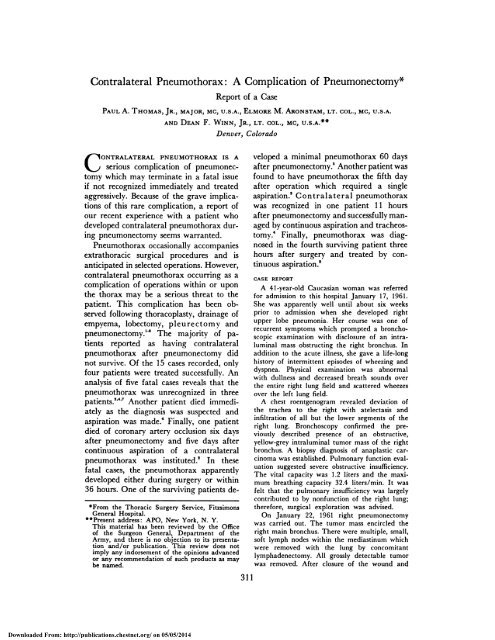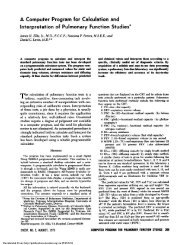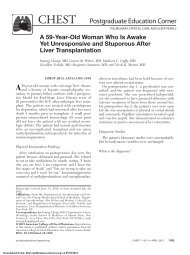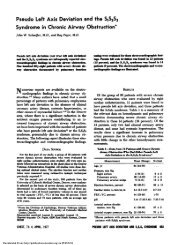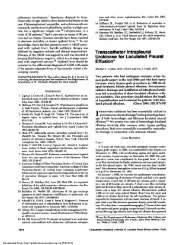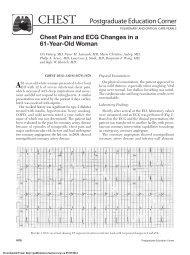Contralateral Pneumothorax: A Complication of ... - CHEST Journal
Contralateral Pneumothorax: A Complication of ... - CHEST Journal
Contralateral Pneumothorax: A Complication of ... - CHEST Journal
Create successful ePaper yourself
Turn your PDF publications into a flip-book with our unique Google optimized e-Paper software.
<strong>Contralateral</strong> <strong>Pneumothorax</strong>: A <strong>Complication</strong> <strong>of</strong> Pneumonectomy*<br />
Report <strong>of</strong> a Case<br />
PAUL A. THOMAS, JR., MAJOR, MC, U.S.A., ELMORE M. ARONSTAM, LT. COL., MC, U.S.A.<br />
Denver,<br />
C ONTRALATERAL PNEUMOTHORAX IS A<br />
serious complication <strong>of</strong> pneumonectomy<br />
which may terminate in a fatal issue<br />
if not recognized immediately and treated<br />
aggressively. Because <strong>of</strong> the grave implications<br />
<strong>of</strong> this rare complication, a report <strong>of</strong><br />
our recent experience with a patient who<br />
developed contralateral pneumothorax during<br />
pneumonectomy seems warranted.<br />
<strong>Pneumothorax</strong> occasionally accompanies<br />
extrathoracic surgical procedures and is<br />
anticipated in selected operations. However,<br />
contralateral pneumothorax occurring as a<br />
complication <strong>of</strong> operations within or upon<br />
the thorax may be a serious threat to the<br />
patient. This complication has been observed<br />
following thoracoplasty, drainage <strong>of</strong><br />
empyema, lobectomy, ple u re Ct o m y and<br />
pneumonectomy.’8 The majority <strong>of</strong> patients<br />
reported as having contralateral<br />
pneumothorax after pneumonectomy did<br />
not survive. Of the 15 cases recorded, only<br />
four patients were treated successfully. An<br />
analysis <strong>of</strong> five fatal cases reveals that the<br />
pneumothorax was unrecognized in three<br />
patients.2’4’7 Another patient died immediately<br />
as the diagnosis was suspected and<br />
aspiration was made.4 Finally, one patient<br />
died <strong>of</strong> coronary artery occlusion six days<br />
after pneumonectomy and five days after<br />
continuous aspiration <strong>of</strong> a contralateral<br />
pneumothorax was instituted.2 In these<br />
fatal cases, the pneumothorax apparently<br />
developed either during surgery or within<br />
36 hours. One <strong>of</strong> the surviving patients de-<br />
*From the Thoracic Surgery Service, Fitzsimons<br />
General Hospital.<br />
**present address: APO, New York, N. Y.<br />
AND DEAN F. WINN, JR., LT. COL., MC, U.S.A.**<br />
This material has been reviewed by the Office<br />
<strong>of</strong> the Surgeon General, Department <strong>of</strong> the<br />
Army, and there is no objection to its presentation<br />
and/or publication. This review does not<br />
imply any indorsement <strong>of</strong> the opinions advanced<br />
or any recommendation <strong>of</strong> such products as may<br />
be named.<br />
311<br />
Colorado<br />
veloped a minimal pneumothorax 60 days<br />
after pneumonectomy.5 Another patient was<br />
found to have pneumothorax the fifth day<br />
after operation which required a single<br />
aspiration.2 <strong>Contralateral</strong> pneumothorax<br />
was recognized in one patient 1 1 hours<br />
after pneumonectomy and successfully managed<br />
by continuous aspiration and tracheostomy.4<br />
Finally, pneumothorax was diagnosed<br />
in the fourth surviving patient three<br />
hours after surgery and treated by continuous<br />
CASE<br />
REPORT<br />
aspiration.’<br />
A 41-year-old Caucasian woman was refenred<br />
for admission to this hospital January 17, 1961.<br />
She was apparently well until about six weeks<br />
prior to admission when she developed right<br />
upper lobe pneumonia. Her course was one <strong>of</strong><br />
recurrent symptoms which prompted a bronchoscopic<br />
examination with disclosure <strong>of</strong> an intnaluminal<br />
mass obstructing the night bronchus. In<br />
addition to the acute illness, she gave a life.long<br />
history <strong>of</strong> intermittent episodes <strong>of</strong> wheezing and<br />
dyspnea. Physical examination was abnormal<br />
with dullness and decreased breath sounds over<br />
the entire right lung field and scattered wheezes<br />
over the left lung field.<br />
A chest roentgenogram revealed deviation <strong>of</strong><br />
the trachea to the right with atelectasis and<br />
infiltration <strong>of</strong> all but the lower segments <strong>of</strong> the<br />
right lung. Bronchoscopy confirmed the previously<br />
described presence <strong>of</strong> an obstructive,<br />
yellow-grey intnaluminal tumor mass <strong>of</strong> the night<br />
bronchus. A biopsy diagnosis <strong>of</strong> anaplastic cancinoma<br />
was established. Pulmonary function evaluation<br />
suggested severe obstructive insufficiency.<br />
The vital capacity was 1.2 liters and the maximum<br />
breathing capacity 32.4 liters/mm. It was<br />
felt that the pulmonary insufficiency was largely<br />
contributed to by nonfunction <strong>of</strong> the night lung;<br />
therefore, surgical exploration was advised.<br />
On January 22, 1961 right pneumonectomy<br />
was carried out. The tumor mass encircled the<br />
right main bronchus. There were multiple, small,<br />
s<strong>of</strong>t lymph nodes within the mediastinum which<br />
were removed with the lung by concomitant<br />
lymphadenectomy. All grossly detectable tumor<br />
was removed. After closure <strong>of</strong> the wound and<br />
Downloaded From: http://publications.chestnet.org/ on 05/05/2014
312<br />
Diseases <strong>of</strong><br />
THOMAS, ARONSTAM AND WINN the Chest<br />
returning the patient to a supine position, the<br />
endotracheal tube was removed. Although she<br />
was waking satisfactorily from anesthesia, spontaneous<br />
respiration appeared difficult and madequate<br />
without support. Breath sounds over the<br />
left lung suggested a prolonged expiratory phase.<br />
Administration <strong>of</strong> intravenous aminophylline did<br />
not relieve the respiratory distress <strong>of</strong> which she<br />
was obviously complaining. Tracheal intubation<br />
was then accomplished to obtain better respinatory<br />
control. Exploratory needle aspiration <strong>of</strong> the<br />
left pleural space revealed the presence <strong>of</strong> tension<br />
pneumothorax. At this time she developed a<br />
rapidly progressing subcutaneous emphysema;<br />
therefore, rapid, closed catheter intubation <strong>of</strong><br />
both pleural spaces was made for decompression.<br />
Portable chest roentgenograms were obtained<br />
and the endotracheal tube manipulated to several<br />
positions in an attempt to define the source<br />
<strong>of</strong> the pneumothorax. These studies were not<br />
productive <strong>of</strong> a precise diagnosis; therefore, the<br />
right chest was reopened to inspect the transected<br />
bronchus which was found securely closed. The<br />
surgery was concluded by tracheostomy. Mechanically<br />
assisted ventilation was instituted and<br />
the patient removed to the recovery area.<br />
The first ten postoperative days were difficult<br />
for the patient. Bronchospasm was counteracted<br />
by administration <strong>of</strong> aminophylline, ephedrine<br />
and isoproterenol. Mechanically assisted ventilation<br />
was required for five days. Pleural space decompression<br />
was necessary for six days and on<br />
one occasion, reinsertion <strong>of</strong> an intercostal catheter<br />
was required. She experienced a serious episode<br />
<strong>of</strong> apparent cerebral anoxia on the seventh postoperative<br />
day when she became irrational and<br />
uncooperative. This subsided over a period <strong>of</strong><br />
hours without specific therapy other than continued<br />
administration <strong>of</strong> oxygen mist. The sungical<br />
wounds healed without complication. The<br />
tracheostomy was finally removed 14 days after<br />
operation. From that time until discharge from<br />
the hospital, she regained hen strength and increased<br />
her respiratory capacity to the point <strong>of</strong><br />
satisfactory ambulation. Presently, ten months<br />
following operation, she is doing well. Postoperative<br />
pulmonary function has not as yet been<br />
evaluated.<br />
DISCUSSION<br />
<strong>Contralateral</strong> pneumothorax is a rare<br />
complication <strong>of</strong> pneumonectomy. It occurs<br />
most frequently in the period immediately<br />
following surgery. Recognition <strong>of</strong> pneumothorax<br />
in the pneumonectomized patient<br />
may be obscure because <strong>of</strong> the catastrophic<br />
seriousness <strong>of</strong> the event. The urgency <strong>of</strong><br />
the situation does not permit elaborate<br />
diagnostic study ; therefore, exploratory<br />
thoracentesis should be done if pneumothorax<br />
is suspected. This may serve as a<br />
temporary method <strong>of</strong> pleural space decompression<br />
until intercostal catheter drainage<br />
can be established.<br />
A foreknowledge <strong>of</strong> respiratory conditions<br />
which might predispose to the postoperative<br />
development <strong>of</strong> pneumothorax<br />
should be helpful. A history <strong>of</strong> previous<br />
pneumothorax is <strong>of</strong> great significance ; contralateral<br />
pneumothorax complicating surgical<br />
treatment <strong>of</strong> recurrent pneumothorax<br />
has been observed frequently. Emphysema<br />
may predispose the patient to this complication<br />
as may other bronchospastic conditions.<br />
Blebs or bullae observed in the resected<br />
lung may serve as a warning as to<br />
the potential possibility.<br />
Treatment <strong>of</strong> this complication is decompression<br />
<strong>of</strong> the pneumothorax and assurance<br />
<strong>of</strong> adequate ventilation <strong>of</strong> the remaining<br />
lung. The most reliable method <strong>of</strong><br />
pleural space decompression is continuous<br />
water seal drainage through a large bore<br />
intercostal catheter. Vigorous treatment is<br />
dictated by the serious threat to survival<br />
<strong>of</strong> the patient following pneumonectomy.<br />
The assurance <strong>of</strong> adequate ventilation is<br />
also a prime consideration. Mechanically<br />
assisted ventilation is indicated in those<br />
individuals with borderline pulmonary<br />
function. A few patients may be able to<br />
breathe spontaneously in spite <strong>of</strong> the discomfort<br />
associated with the presence <strong>of</strong> a<br />
draining catheter on one side and a thoracotomy<br />
incision on the other. However,<br />
this aspect <strong>of</strong> management must be mdividualized.<br />
REFERENCES<br />
1 BENO, T. J. AND WEISEL, W. : “Spontaneous<br />
<strong>Contralateral</strong> P n e u m o t 0 r a x Complicating<br />
Thoracic Surgical Procedures,” J. Thor. Surg.,<br />
23:272, 1952.<br />
2 BLALOCK, J. B.: “Contralatenal <strong>Pneumothorax</strong><br />
after Pneumonectomy for Carcinoma,” Dis.<br />
Chest, 37:371, 1960.<br />
3 GLEASON, G. E., ASPINWALL, P. A. AND KENT,<br />
E. M.: “<strong>Contralateral</strong> Spontaneous <strong>Pneumothorax</strong><br />
Following Lobectomy,” J. Thor. Surg.,<br />
18:473, 1949.<br />
Downloaded From: http://publications.chestnet.org/ on 05/05/2014
Volume 43, No. 3<br />
March 1963<br />
CONTRALATERAL PNEUMOTHORAX 313<br />
4 LEBRIGAND, H., MERLIER, M., HUMMEL, J.<br />
AND TRIBOULET, F.: “Les <strong>Pneumothorax</strong> Spontanes<br />
Controlateraux apres Pneumonectomie,”<br />
Poumon et Coeur, 12:699, 1956.<br />
5 MELICK, D. W. AND GUTEKUNST, R. A.:<br />
“Spontaneous <strong>Pneumothorax</strong> following Pneumonectomy,”<br />
Am. Rev. Tuberc., 62:116, 1950.<br />
6 SABETY, A. M.: “<strong>Contralateral</strong> Spontaneous<br />
<strong>Pneumothorax</strong> as a <strong>Complication</strong> <strong>of</strong> Intrathoracic<br />
Operations,” Dis. Chest, 27:201, 1955.<br />
7 STEPHENS, H. B.: “A Consideration <strong>of</strong> <strong>Contralateral</strong><br />
<strong>Pneumothorax</strong> as a <strong>Complication</strong> <strong>of</strong><br />
Intrathoracic Operations,” J. Thor. Surg., 5:<br />
471, 1935-36.<br />
8 THOMAS, P. A. AND GEBAUER, P. W.: “Results<br />
and <strong>Complication</strong>s <strong>of</strong> Pleurectomy for<br />
Bullous Emphysema and Recurrent <strong>Pneumothorax</strong>,”<br />
J. Thor. and Cardiovas. Surg., 39:<br />
194, 1960.<br />
CLINICAL ASPECTS OF AURICULAR FLUTTER<br />
At the Instituto Naclonal de Cardlologia, 230 cases<br />
<strong>of</strong> atnial flutter were found among 60,000 charts.<br />
Of these, 54,000 were cases <strong>of</strong> true heart disease<br />
and the remainder had no demonstrable cardiac disease.<br />
In the first group, the Incidence <strong>of</strong> flutter was<br />
0.4 per cent and In the second, one per thousand.<br />
Flutter was more common in men.<br />
In cardiac patients, the most common etlologic<br />
factor was rheumatic fever (67.8 per cent). One<br />
hundred ninety-eight cases had cardlomegaly. The<br />
duration <strong>of</strong> flutter could be established in 97 cases.<br />
In 37, it was under two weeks and In 16, it was<br />
permanent. Of 23 cases with a necropsy record, 68<br />
per cent had thrombosis and/or parietal endocanditis.<br />
Of nine cases treated with digitalis, 2 per cent<br />
were refractory to the treatment ; 61 per cent were<br />
changed to auricular fibrillation and 37 per cent to<br />
sinus rhythm. Fifteen per cent <strong>of</strong> the cases treated<br />
with qulnidine did not respond to therapy. In cases<br />
treated with digitalis and quinidlne, 18.7 pen cent<br />
were refractory to treatment,<br />
CARDENAS, M. AND AMEZCUA, F. J.: “Aspectos Clinicos del<br />
Fiutter Auricuiar,” Arch. Inst. Cardiol. Mexico, 32:283.<br />
1962.<br />
PLASMA NOR-EPINEPHRINE RESPONSE<br />
Increased activity <strong>of</strong> the sympathetic nervous<br />
system has been considered a major determinant <strong>of</strong><br />
the circulatory response to muscular exercise, This<br />
study was undertaken in an effort to compare the<br />
activity <strong>of</strong> this system, as reflected by the concentration<br />
<strong>of</strong> nor-epinephnine in arterial blood in nonmal<br />
subjects and in patients with cardiac disease.<br />
In five normal subjects, moderate muscular exercise<br />
was associated with a slight elevation <strong>of</strong> arterial<br />
nor-epinephnine from an average level <strong>of</strong> 0.28 to<br />
0.46 meg. per liter. With more strenuous exercise,<br />
the level averaged 0.62 mcg. pen liter, In seven<br />
patients with congestive heart failure, moderate<br />
exercise elevated the arterial nor-pinephnine from<br />
an average <strong>of</strong> 0.63 to 1.73 meg. per liter. In three<br />
patients with heart disease without failure, the resting<br />
and exercise levels were similar to those noted<br />
in the normal subjects. It is concluded that the<br />
excessive augmentation <strong>of</strong> the plasma nor-epinephnine<br />
during exercise in these patients with congestive<br />
heart failure reflects an Increased response <strong>of</strong><br />
the sympathetic nervous system and that this nosponse<br />
may have an important supportive role In<br />
such patients.<br />
CHIDSEY. C. A., HARRISON, D. C. AND BRAUNWALD, E.:<br />
‘ Augmentation <strong>of</strong> the Plasma Nor.epinephrine Response to<br />
Exercise in Patients with Congestive Heart Failure,” New<br />
Engl. J. Med., 267:650, 1962.<br />
EXPERIENCES WITH CORONARY ENDARTERECTOMY<br />
Over a three and one-half year period, endarterectomy<br />
<strong>of</strong> the coronary artery was performed on five<br />
patients. In two, restoration <strong>of</strong> arterial continuity<br />
was successful. One <strong>of</strong> these segments closed Immediately,<br />
the other after a six-month period, and<br />
the patient’s previous symptoms <strong>of</strong> angina then<br />
returned, Two <strong>of</strong> the other three patients died In<br />
connection with the operation.<br />
WARREN, R. : ‘ ‘Experiences with Coronary Endarterectomy,”<br />
I. Cardiovasc. Surg., 3:281, 1962.<br />
Downloaded From: http://publications.chestnet.org/ on 05/05/2014


